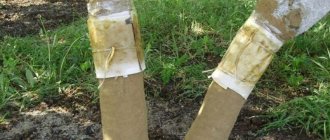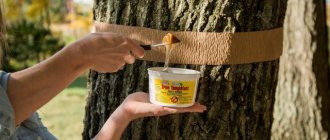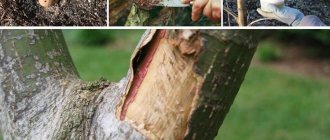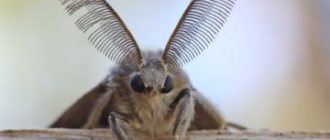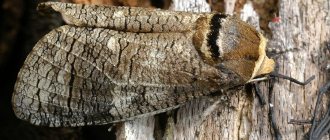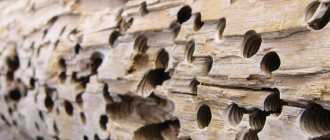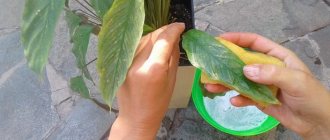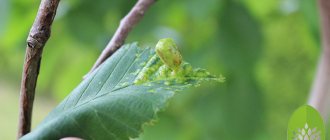There are many different traps designed to reduce garden pests. Popular adhesive trapping belts for trees largely block the pest's path to the tree crown and hold it tightly. An adhesive catch belt is a strip of fabric, paper or other material, onto the surface of which a special glue is applied that does not harden for a long time. The benefits of this remedy are obvious, but there is also “the other side of the coin.”
Glue catching belt with insect pests stuck to it
Are adhesive catch belts always effective?
Any hunting adhesive belts, purchased or homemade, live up to their name. The codling moth, weevils, bark beetles and many other bugs, moths and caterpillars stick to them. Trap belts do stop most of these pests from climbing up a tree trunk. The exception is ants. But fighting them is the key to the health and cleanliness of the garden. These intelligent creatures that spread pests manage to crawl calmly under obstacles. They find minor depressions and cracks in the bark of an adult tree and calmly move along them. Take a closer look: there will be very few stuck ants on most hunting belts. It practically does not interfere with their movement on the trunk of an old tree. Therefore, glue belts are 100% effective only on young trees with absolutely smooth bark.
Wide glue trapping belt on the smooth bark of a young apple tree trunk
There are several other options for catching belts that also help gardeners protect trees from pests. This is a strip attached to a tree, treated with broad-spectrum insecticides. Because of them, the pests die and instantly fall to the ground. The impregnation needs to be updated periodically.
Various traps are also worth mentioning. Some designs are built into fishing belts.
Funnel belt
The funnel belt is distinguished by its simplicity of design. At the same time, it shows high efficiency in the fight against insect pests.
The funnel-shaped shape of the trap ensures that beetles trapped inside cannot escape.
Making a hunting funnel belt is simple:
- A strip is cut out of a sheet of thick cardboard, its width should be 15-20 cm, and its length should be equal to the circumference of the trunk.
- The belt is wrapped around the tree at a height of 50 cm from the root system and secured with twine to form a skirt. The funnel will prevent insects from crawling up the trunk.
- Where the skirt is attached to the trunk, you will need to carefully coat the cracks with clay.
DIY adhesive catching belts
It’s easy to make a classic version of a hunting belt with your own hands. This is a sticky strip of fabric or other material that fits tightly around the bark of a tree. Typically, burlap, thin foam rubber, rolled baking paper, wax paper, corrugated cardboard, etc. are used. A thick layer of garden moisture-resistant non-drying glue (Vesta, Uniflex, BioMaster, Ecotrap, etc.) is applied to them. If you were unable to buy such glue, then the one used for rodents will do. There are universal compounds designed to catch and destroy crawling and flying insect pests, as well as rodents. For example, the inexpensive Belarusian adhesive composition “Uniflex”. The base made of waterproof material can be reused many times. Each time a new layer of glue is applied to it.
Hunting belts are used to edge the trunk (trunk) of a tree at a height of 30 - 90 cm from the ground and secure the belt with twine. They are also attached to thick skeletal branches. The pest either dies, glued to the belt, or refuses to attempt to get over an insurmountable obstacle. In dry weather (from early spring to late autumn), the belt must be changed at least once a month; in rainy weather, the hunting belts must be removed every 10 days.
In spring, when the air temperature is above plus 6°C, pests begin to actively crawl along tree trunks. In autumn (from September), the main flow is directed from the ground in search of a place under the bark for overwintering.
In another option, a waterproof dense material about 20 cm wide is attached to the tree trunk. This can be burlap, glass wool, a strip of foam rubber, laminate backing, etc. 2 - 3 narrow strips of glue are applied to it. You can do it differently: put the glue belt not on the tree bark, but on this base.
The trunk of the tree on which the hunting belt will be attached is first cleaned of pieces of peeling bark, growths, lichen, moss, etc. The glue strips are applied with a grip.
It is better to work with gloves, otherwise your fingers will soon become sticky. It is advisable to immediately remove the glue and scissors.
Ready-made catching belts with rolls of double-sided adhesive tape are convenient. On sale there are adhesive belts “Trap, Green Pharmacy Gardener”, “Aeroxon, adhesive belt for trees 3.5 m with fastening rope”, “Trapper belt made of parchment with Uniflex adhesive composition”, “Evil TED 5 m”, “ARGUS, catching belt for trees against garden pests”, “Mashenka (5 m)”, etc.
Kinds
Trap belts are effective against those pests that rise from the ground up the trunk in search of food. These include the most unpleasant insects for gardeners:
- weevils;
- all types of caterpillars;
- mites;
- bukarki;
- geese;
- aphids;
- flower beetles.
Insect traps are divided by design and operating principle.
The following types of catch belts exist:
- dry;
- insecticidal;
- sticky.
Dry belts are a common trap made of coarse fabric or burlap. Insecticidal belts are distinguished by the fact that the fabric is impregnated with a substance that is harmful to insects. Sticky belts are coated with an adhesive, non-drying substance and act like household fly sticks. The belts are safe for the fruit tree and humans. The main disadvantage of such structures is that insects beneficial to trees often get caught in them and die. Homemade catching belts have different designs and can be made from any available materials. Read how to store apple tree cuttings for grafting here.
Dry
You can make a simple dry trap belt with your own hands in a few minutes. To do this you will need the following:
- foam;
- scotch;
- stretch film;
- scissors;
- knife.
Take a strip of foam rubber 15-25 mm thick and 25-30 cm wide. The length of the strip is selected so that it can be wrapped around the tree trunk in one layer, but with a margin of 10-15 cm. Next, the strip is fixed on the trunk using tape , then wrapped in two or three layers of stretch film. The film is carefully smoothed out and its excess is cut off. The trap should be checked once a week. Caught insects are shaken off and burned. Instead of foam rubber, you can use coarse fabric, burlap or a strip of glass wool. Care must be taken when handling glass wool.
There is a very simple semi-dry type design. The tree trunk is wrapped in burlap in 2-3 layers in two places. The first belt is located 20 cm from the ground, and the second harness is made 20 cm below the tree crown. The fabric is wrapped in film, onto which a layer of grease is applied. Solid oil should be renewed at least once a month. The belts are tied in early spring and removed at the end of August. Gardeners often use homemade insecticide belts. To do this, a layer of foam rubber or burlap is impregnated with toxic chemicals.
Anti-insect belts have no effect on ants, which, due to their small size, climb the trunk using cracks in the bark. Experienced gardeners soak the fabric with unrefined sunflower oil, which repels these insects.
Funnel
This design can also be made with your own hands.
For the funnel, you can use almost any material that you have on hand. The main task of the funnel belt is to prevent insects from moving from bottom to top along the trunk. The belt can be made from thick paper or cardboard, but it will last until the first rain, so it is best to use synthetic materials. This may be a strip of thin plastic. Plastic containers from various drinks are well suited for making a funnel belt. The expanding cone-shaped part that starts under the neck should be cut off from the bottle. The throat itself is cut. The conical part is cut lengthwise so that it can be put on the trunk. Several vertical cuts are made in the narrow part so that the structure fits better to the trunk. The cone is placed on the trunk of a young tree and secured with twine, insulating tape or tape. It is not recommended to attach the structure to the bark using glue. If the trunk is thick, you can use large-capacity plastic dishes or make a funnel from several parts, connecting them overlapping. It is best to install a funnel belt at the end of April, beginning of May, when all the pests that have spent the winter in the ground wake up and begin to climb the trunk in search of food. Find out about the characteristics and description of the Anzur bow here.
Non-drying glue or thick lubricating oil can be applied to the inside of the funnel. For this purpose, regular or technical Vaseline, which does not contain toxic substances, is suitable.
Gate
The collar belt is a little more complex in design than a funnel, but its effectiveness is higher, since the insects do not remain alive, but die almost immediately. To make such a trap you will need the following:
- sheet rubber strip;
- rubber glue;
- cord or tape;
- scissors.
Take a strip of rubber 3-5 mm thick and 25-35 cm wide. The strip should be wrapped around the barrel with a small margin. The ends of the strip are glued together with rubber glue. Then the upper part of the rubber belt is tightly fixed to the tree trunk using a cord or tape. The lower part must be folded upward to form a ring cuvette. 3-4 cm of water and a little vegetable oil are poured into it so that an oil film forms on the surface. Once trapped, insects lose the ability to move and die. You just need to clean the container from insects from time to time and add water and oil. This material will tell you about transplanting an apple tree to a new place in the spring.
Before installing an insect trap on the trunk, you need to thoroughly clean the bark of dead growths, and cover deep cracks and cracks with garden pitch or clay.
Double-sided funnel
When protecting any varieties, including Bogatyr and Cinnamon Striped, from insects, it should be taken into account that they move not only from bottom to top, but also from top to bottom. To protect the tree on both sides, the funnel must have conical extensions directed in both directions. This design can be made from sheet plastic or plastic bottles. Essentially these are two differently directed bells. Their narrow parts are firmly fixed to the trunk with twine or adhesive tape. To attract insects, some gardeners apply a small amount of jam inside the funnel. The bad thing is that the bees may be harmed. Find out how to graft a pear onto a pear in this article.
Sticky
Sticky insect traps involve the use of special compounds that are an insurmountable barrier for insects. The simplest adhesive trap is a strip of fabric, paper or other material that is coated with a non-drying adhesive and fixed to a tree trunk.
Such traps are good at capturing codling moths, weevils, bark beetles and many other species, with the exception of ants.
Only ants find their way into the folds of the bark. Glue belts are especially effective on young trees with smooth bark because there are no cracks that small insects can exploit.
Any thick fabric, corrugated cardboard or foam rubber is suitable for making a hunting belt. A strip of material 25-35 cm wide is secured to the tree trunk with adhesive tape or twine at a height of 40-50 cm from the ground. Then a moisture-resistant and non-drying glue is applied to it. The most commonly used adhesives are:
- Vesta;
- biomaster;
- uniflex.
When pests enter a sticky environment, they become immobile and die. Adhesive belts protect not only the main trunk, but also large skeletal branches from insects. Such belts are suitable for Marble and Cathedral pears, as they have tall and spreading branches. Belts can be fastened from early spring until the end of autumn. You need to change the glue trap or renew the glue layer at least once a month. Typically, insects, in spring, become active at a temperature of + 60C and begin to actively move along tree trunks. Closer to autumn, the main flow of insects is directed downwards, where the bark is coarser and thicker and where, in the cracks, a place for wintering can be found.
The place on the tree trunk where the adhesive belt will be attached must be cleared of old bark, various growths, moss and lichen. Some gardeners use wide double-sided tape to protect the tree from insects. It should be borne in mind that synthetic-based trapping belts can cause some harm to the tree. Since they do not allow air to pass through, the bark underneath them may dry out. If the belts are left on the trunk during frosts, the slightest moisture remaining under them can lead to the appearance of microcracks in the tree bark. When to remove cover from apple trees in the spring, read this link.
Damage caused by adhesive catch belts
Hunting belts can do a disservice by damaging tree bark. Even when everything is done strictly according to the instructions. I encountered damping off of the bark. With all the ensuing consequences. There is no air access under the tight-fitting wide strip.
Hunting belts left on a tree for a long time in the pre-winter period are dangerous. During this cold season, the air temperature often drops below zero. Even slight moisture accumulated under the belt in frosty weather leads to the appearance of many microscopic cracks. Result: peeling of bark or frost marks on the trunk.
Problems with the bark of this tree began with a glue trap belt
In recent years I have stopped using glue belts in the garden. Unfortunately, I had to learn not only from other people’s mistakes, but also from my own mistakes.
Poison Defense
Many gardeners are afraid to use such insect catchers, believing that the toxic substance can get on the fruits. In reality, this is not the case, because the trap is attached to the trunk at its foot, and pesticides do not penetrate either the root system or get on the foliage.
This type of hunting belt is considered the most effective. It guarantees almost 100% effect. Pests crawling into the trapping device are unable to get out of it and die from chemical fumes.
It is better to attach such a trap to an apple tree - it most effectively prevents the movement of caterpillars towards the crown from the ground. A poisonous catcher belt is made as follows:
- Take a blank made of burlap or other material 20-25 cm wide.
- Impregnate the material with insecticide and fasten it, wrapping it around the trunk, placing the device at a height of 40-50 cm from the roots so that a “skirt” comes out.
- The top of the belt is additionally wrapped with film so that the toxic substance does not erode.
In the manufacture of a poisonous hunting belt, purchased ready-made toxic chemicals approved for use are used. During operation and fastening of the device, precautions should be taken. Don't ignore the use of gloves.
Installation period for catch belts
They begin to attach trapping belts to protect trees from pests before the buds swell, in order to prevent the transition of some of their species, overwintering in the ground, to the crown of the tree. In order for the protection from trapping belts to work as efficiently as possible, their installation must be correlated with the development cycle of pests:
- Against weevils, aphids, ants, herbivorous mites, and whiteflies, trapping sticky belts are installed from March-April until June and in the fall in September-October (after harvesting the fruits). Conventional fishing belts are inspected every 2 weeks and, if necessary, replaced with new ones (old ones are burned). Fishing belts treated with adhesive aerosol are removed once at the end of the season.
- Against caterpillars of codling moths and moths, belts are applied from the second half of June (before harvesting the fruits of early varieties) until full harvesting (September-October). If there are aphids and ants in the garden, then trapping belts are applied from early spring (when the ants wake up) until late autumn. Household ants move their “cows” from their winter quarters to trees in the spring and, conversely, return them to their winter quarters in the fall.
For garden care, treating trapping belts with a new aerosol will help get rid of pests, save health and time, and their cost will practically not change the family budget. Don't miss out on new items! This is a worthwhile find for gardeners.
How to make
There are several options for making a catch belt. Below we present the most popular ones.
Vegetable oil
Vegetable oil is an affordable product that is always on hand. Apply a generous layer of vegetable oil to the tree bark at a height of 30-40 cm from the soil (replacing vegetable oil with linseed, hemp, etc. is acceptable). Experienced gardeners advise adding a little stove soot to the oil.
Advice! In order to achieve even greater effect from the activities, you can alternate oil barriers and strips with an adhesive base.
Skirt
This method is inexpensive and easy to use. To use it, you need to prepare ordinary kitchen foil in advance. You need to wrap it around the trunk of a fruit-bearing tree in such a way that it looks like a skirt. Ants “don’t like” to get over the sharp edge of this material, and most often they quickly give up, which means they will soon leave the fruit-bearing tree.
Resin or tar
Resin and tar are very popular in the fight against ants on fruit trees. Insects that fall on these Velcro cannot get out of them and die. In order to make a belt using these materials, you must perform the following steps:
- You need to wrap the trunk of the fruit tree in two layers with pre-prepared plastic film at a height of approximately 30 cm above ground level;
- Apply a small layer of resin, tar (solidol or other similar substance) to the surface of the bag;
- The trap must be updated periodically.
Advice! In order to destroy even more ants using a hunting belt, we recommend that instead of adhesive substances, apply a special insecticidal gel to the polyethylene, which is not only a bait, but also a poison for insects. The ant eats the composition, which lures it with a sweet smell, and, getting into the anthill, poisons the rest of its relatives.
Gate trap
Let's imagine another common mechanism in the fight against ants on fruit trees. This is a trap-gate. To install such a trap, you must sequentially perform the following steps:
- on the tree trunk you need to mark a distance equal to 50 centimeters from the ground;
- measure the volume of green space around the perimeter;
- cut a wide strip of rubber equal to the measured volume;
- wrap the cut strip around the tree trunk, bending the edges to make a kind of collar;
- The ends of the rubber are fastened together with glue. The result will be achieved if you use a special adhesive composition against ants, which is toxic and leads to their death;
- As a result of the activities carried out, you will get a rubber container into which you can additionally pour vegetable oil.
Such a rubber gate will need to be periodically changed as the tree grows, and the rubber container will also need to be cleaned of insects and debris that have gotten into it and additionally filled with sunflower oil.
Advice! For long-term use of the trap, it is recommended to make it from soft rubber.
Funnels
Funnel traps are so named because they resemble an inverted cone in appearance. They are quite simple to make. You can easily make them yourself:
- Prepare in advance thick sheets of cardboard, paper, padding polyester, burlap, holofiber, which will be attached to the tree as a trap for ants.
- At a height of 50 cm from the ground, these sheets must be wrapped around the tree trunk so that the lower edges of the paper or padding polyester fit tightly to the trunk. In this case, the upper edge should be at a sufficient distance from the bark of the green space. This creates a funnel effect. An ant, falling into such a trap, will no longer be able to get out of it.
- It is recommended to secure the lower part of the funnel tightly to the tree, additionally strengthening the structure with a rope or wire, and also coat all gaps (if any) with clay.
The structure can be disposed of after use by fire. Unnecessary traps should be burned.
Double-sided funnels
Double-sided funnels are a means of fighting ants that can be used in two directions at once.
Firstly, such funnels prevent insects from climbing up the tree trunk. Secondly, they also act as a barrier to the ants descending for the pupation process.
To install such a structure on a tree trunk, you need to perform the following steps:
- prepare thick paper or cardboard (the width of the sheet of material used must be at least 30 cm);
- the paper must be wrapped around the trunk at a height of about 40-50 cm above ground level, while visually dividing it into three equal parts;
- you need to attach the paper base to the trunk in the middle, taking into account that the upper and lower edges should remain free;
- If there are gaps where the paper is attached to the green space, they must be covered with clay.
Pests destroyed by trapping belts
These life hacks turned out to be very successful. Using catching belts, you can significantly reduce the number of insect pests. Pest catching belts are best suited for killing caterpillars of plum, apple and pear moths. Hunting belts serve as good protection against damage by beetles - gray bud beetle (bud weevil), apple flower beetle, geese, beetles, as well as fruit moths, mites, whiteflies, aphids and other pests. Properly installed trapping belts are an insurmountable barrier for ants.
